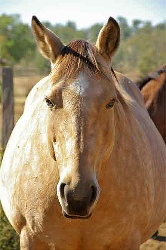Facilities:
Ideally the mare should have a nice clean (manure picked up), grassed paddock, which has not been grazed by other horses for 2-3 months (no worm infestation, good grass cover), though this is not always possible.
- The paddock should be dog & vermin proof if possible.

- Good lighting is handy, but a good torch (working batteries) may be sufficient.
- Availability of a confined area (stable/yard) to catch, treat (medically) or handle your foal is advisable.
The birth:
It is ideal for someone to be there during the birth, so that any complications that arise can be attended to immediately to ensure the best possible chance of having a viable mare & a live, healthy foal.
Most studs employ people to do the foal watch (all night) to ensure that the birth of the foal is monitored closely.
Signs of impending birth:
- The udder will start to enlarge within the last week or two.
- Wax may appear on the end of her teat (usually honey coloured discharge) within a few days of the birth. Sometimes this can occur up to 4 weeks before they give birth.
- Mares sometimes drip milk before foaling. If this occurs more than a week prior to giving birth it may result in loss of colostrum, so if this occurs it may be worthwhile supplementing the foal with colostrum or having its immunity levels checked within 24 hrs of birth. Low immunity can be corrected with the aid of Plasma supplementation.
- A couple of days before the birth the vaginal area will soften & become floppy.
- The area around the rump may flatten &/or dip as the bone connections soften. Though in some breeds (quater horses etc) or where the mare is fat this may not be apparent.
- The back may also look "dropped" in appearance.

- They may get swelling either in their legs or down underneath their belly (this can occur up to a month or before the birth).
- It is not unusual for few, if any, of the signs listed above to be apparent before the birth & for the owners to wake up in the morning & find a live & healthy foal, or a very sick or even a dead foal in their paddock.
- This highlights the importance of knowing the expected birth date & conducting a proper Foal Watch.
- When the mare is due it may foal at anytime, but the most common time is usually very early morning or as soon as you have walked inside to make a well deserved cup of coffee. The foal can be on the ground or be in difficulty before that coffee is finished.
Foal Watch:
- The mare should be checked at least every 2 hours (ideally hourly or continually as is done on studs) throughout the night within a couple of days of her due date, or if she is showing any of the above signs.
- The mare may separate from the herd.
- She may select a particular area and spend time "hanging around" there.
- She may spend a bit more time lying down than usual a day or so before the birth.
Signs of Labour:
- Mare may appear uncomfortable or restless (stand up & lie down).
Labour:
Labour usually happens fairly quickly because horses are a flight animal & in the wild predators could attack them or the (unprotected) foal if they spend large amounts of time lying down.
- The mare will show signs of straining.
- A water bag will appear at the vulva.
- The mare usually lies down, but some foals are born while the mare is standing up.
- The birth itself usually only takes a few minutes, sometimes it can be longer depending on how big the foal is & whether there are any abnormalities of presentation (leg or head back, wrong positioning).Once the mare starts to squeeze (she does this very strongly) things should progress every 5 minutes, for example:
- Within 5 minutes of squeezing the bag should appear & possibly burst.
- Within 5 minutes of this there should be legs &/or nose presented.
- Within 5 minutes of this the head should be out & the shoulders should be coming.
- Within 5 minutes of this the foal should be out.
Generally the whole birth is over within half an hour. This is because unlike cattle, the whole of the placenta detaches at the same time, and if the foal does not come out fairly quickly it can suffer from lack of oxygen & die or have serious post-birth problems because of brain damage. Therefore it is very important to get the foal out within a short period of time, which requires close monitoring.
Complications
Mares should not be left in labour for more than 30 minutes. Ideally help should be sort for the mare within this time. So if she starts straining & isn't progressing as described above (within 5-10 min.) then you should be concerned & consider calling your vet for assistance.
The foal can be born with the placental "bag" intact (not broken), leaving a healthy live foal to suffocate. This is a common occurrence in unobserved births. You can manually break the bag yourself & prevent a lot of heartache.
The placenta, or afterbirth, should be checked for completeness (no pieces left inside). It is usually a rough Y shape with two rounded ends. If the two rounded ends are not there then there will be problems because more than likely a piece of it has been left behind (associated problems shown below).
If the afterbirth has not come out after 4-6 hours you should get some assistance from a vet to get it out. After 8 hours it can cause infection, inflammation, colic, toxicity & founder, all of which may need ongoing veterinary treatment. Left untreated there is the possibility of losing both the mare & the foal.
If the afterbirth cannot be found it can be presumed that it has been retained & the mare will need veterinary attention. Horses are herbivores & unlike other species do not eat the afterbirth. However other animals such as dogs and foxes may remove and/or eat the afterbirth before the next morning.
Abnormalities - When to call your vet.
- If the foal doesn't look like it knows what's going on, looks slow, sleepy (drowsy), inactive, not alert, not moving or not trying to get up & drink fairly quickly.
- If there is excessive bleeding from the umbilical cord.
- If there is a lot of blood coming from the mare.
- If the mare lies down & doesn't get up at all. This could be indicative of a number of complications or it may just be that she is sore (this is not unusual for maiden mares).
- If the mare prolapses its uterus (looks like meaty red lump of flesh which pops out of the vagina) she should be kept calm & relaxed until the vet arrives. This is a life-threatening emergency.
- If the mare dies. Foals health & immunity level may need to be checked.
- If your foal looks sick at all ring your vet. It doesn't hurt to talk about it & bear in mind that a healthy foal that becomes sick can die within 12 hours. Sick foals need to be treated early because they do not have any reserves of energy & they can die very fast.
After the birth care:
Normally there is no need to disturb the mare & foal too much.
- If the afterbirth has come out with the foal, check that it is clear of the foals head so that it can breathe.
- The afterbirth should be passed within half an hour to an hour of the birth, though it can take up to 3-4 hours.
- It is a good idea to collect the afterbirth in a bucket & store it in a cool place in case your vet needs to examine it. This is especially important if you are not sure if it is complete or if the mare or foals health is compromised in any way.
- Keep a discreet eye on them, making sure the mare gets up & appears to accept the foal (she may lick and clean the foal).
- The foal should get up within 30- 60 minutes. Once it gets up it should go & have a drink.
- It is important that it has a good drink within a few hours. Some foals will get up immediately & have a drink straight away. Some may take a little longer.
A common problem with maiden mares is that they don't understand what's going on & may get agitated about having the foal drinking from them. If this occurs you may need to consider holding the mare (some may need to be twitched) or in some circumstances the mare may need to be sedated (by your vet) if she is having problems accepting the foal.
Generally if the mare & foal are put into a confined area the mare will accept the foal after a little while.
Some mares will actually try to kick or bite the foal. These mares should be supervised & held until they get use to their foal.
In rare circumstances the mare will not accept the foal & supplementary feeding with veterinary advice may be necessary.
The umbilical cord usually ruptures itself. It's a good idea to have iodine/vetadine/chlorhexadine on hand to spray or swab liberally on the foal's umbilical cord to help stop the chance of infection. Umbilical contamination is one of the commonest ways of the foal picking up infections and may lead to life-threatening complications.
You must ensure that the foal passes its meconium (the first manure). This is usually black or dark brown in colour in pellets & can be quite firm. It is not uncommon for a foal to have an impaction of the meconium. This can be removed by gently inserting a gloved lubricated finger into the anus of the foal & gently scooping it out. In some instances your vet may need to administer an enema or paraffin oil to your foal. On rare occasions it may require surgical removal.
If the meconium is left, the foal can get colic, roll, feel uncomfortable & be in too much pain to drink, which will lead to dehydration & possible death.
Normally the meconium passes within 6-12 hours. You will then have orange coloured "baby poo". Simply, if your foal has bright orange coloured manure (NOT diarrhoea!!) you know it has passed its meconium.
If there is no manure or it is brown or black then there may be a problem. This can be checked easily by inserting a gloved lubricated finger in the anus & scooping out what's there & looking at it. If in doubt call your vet & discuss it with them.
Preventative measures:
Foaling Alarms: - A mercury switch that is connected to the halter & is left on the mare at all times. This can be monitored in the house at all times via a radio transmitter. When the mare lies down the switch is flicked & an alarm goes off to alert you to check the mare. More often than not you will find her standing there looking at you over the fence. Even though there may be several false alarms it does give you piece of mind that you will be there to assist the mare if needed. Many studs use this useful device.
Note: Keep in mind that foaling alarms are not 100% full proof. Observe close monitoring of pregnant mares close to term.
Post foaling vet checks:
Check that the afterbirth is intact. It is a complete bag in a Y shape that is intact except where the foal has come out. It should hold water if filled. If there are any tears or pieces missing, you will need to get your vet to check your mare to see if there is any afterbirth remaining inside her.
If you are not sure whether the afterbirth is intact it may be a good idea to get it checked, particularly if your mare is looking uncomfortable as retained foetal membranes (afterbirth) may cause serious health complications for your mare.
IgG Test: - The foals' immunity can be checked at 12-24 hrs especially if the foal is not drinking frequently (average 3-6 times/hr). This is definitely needed at more than 24 hrs if the foal is to be insured. This test checks the foal's Immunoglobulin level, which is an indication of the level of antibodies in the foal's body. If these levels are low Colostrum can be given up to 24 hrs old. After this Plasma is administered as the foal absorbs minimal Colostrum after 24 hrs.
Suggestions:
It's a good idea to read a good book on foaling months before your foal is due so that you have got the correct preparations in place to optimise your chances of having a healthy mare & foal.
If you have any questions or concerns, call your vet for advice, that is what they are trained for & it may help your peace of mind.
Happy Foaling!









